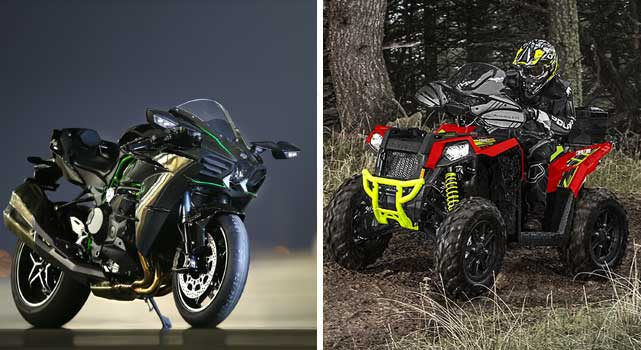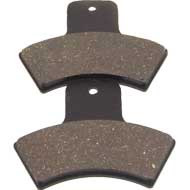Choosing the Right Brake Pad for Motorcycles and ATVs
Aug 15th 2018
Choosing the Right Brake Pad for Motorcycles and ATVs

Whether it’s the blistering, full-on speed of the supercharged Kawasaki Ninja H2 super sport bike or the brute strength of the Polaris Scrambler XP1000 racing ATV, remember the famous adage: Power is nothing without control. Brakes are an often-overlooked component to the complete performance package and should be one of the first items addressed when doing your basic maintenance or a total performance build. After all, what good is a high horsepower, dedicated performance machine if it cannot stop?
Performance car and truck enthusiasts know that there are many different types of brake pads and brake pad compounds and it is absolutely no different for motorcycles and ATVs. Let’s take a quick moment to discuss some important aspects to consider when it comes time to choose the right brake pad for your motorcycle or off-road all-terrain vehicle.
#1: BRAKE PAD GRADES
The Department of Transport mandates that all street legal brake pads fall under a specific grading system. Brake pads are graded between the letters E through H with E being the minimum requirement and H being the maximum. This two-letter edge code can be found printed on the brake pads and are used to identify the pad’s fade (the reduction of stopping power in high load/high speed conditions) resistance. The edge codes are as follows:
| Official D.O.T. Edge Code |
Coefficient of Friction (C.F.)
@ 250 F and @ 600 F |
Comments |
| EE | 0.25 to 0.35 both temps | 0-25% fade at 600 F possible |
| FE |
0.25 to 0.35 @ 250 F
0.35 to 0.45 @ 600 F |
2% to 44% fade at 600 F possible |
| FF | 0.35 to 0.45 both temps | 0-22% fade at 600 F possible |
| GG | 0.45 to 0.55 | Very Rare |
| HH | 0.55 to 0.65 |
Carbon/Carbon only.
O.K. up to 3000 F where it glows |
The coefficient of friction is rated between 250°F (cold) and 600°F (hot). When looking at the code, the first letter represents the coefficient of friction grading at 250°F and the second letter at 600°F. Each letter grade can have a significant range in coefficient of friction, but a difference in letter grade, such as an FE or EF pad, can denote brake fade. These letters can be in any order, but do not mean the same thing.EXAMPLE: FE pads fade when hot. EF pads won’t grab when cold.
Brake pads that are rated FF are considered to be the beginning level of the high-performance category.
#2: BRAKE PAD COMPOUNDS
The brake pad is the chunk of abrasive material that grips onto the brake rotor in a disc brake system. Brake pads are made from a variety of different substances, glues, and binding agents and are classified in three primary categories:
- ORGANIC
- METALLIC
- CERAMIC
Organic (also known as NAO or Non-Asbestos Organic) brake pads were first developed as an alternative to the asbestos brake pad after it was found that asbestos is a carcinogen. Organic brake pads can use rubber, carbon, glass, and Kevlar as part of the friction material and, as such, are extremely gentle on brake rotors and inexpensive to replace.
Metallic pads use between 30% to 65% metal content in the friction material. Metals that are commonly used include steel, iron, and copper. Metallic brake pads are tough and durable but require a careful burnishing process in order to achieve maximum performance. Failure to properly burnish metallic brake pads can actually result in decreased performance.
Ceramic brake pads are relatively new innovations in comparison to the organic and metallic type. Ceramic brake pads are constructed from a dense ceramic substance (like pottery clay that is fired in a kiln) that is embedded with copper fiber. Ceramic pads are the most technologically advanced, offering cleaner and quieter use with greater lifespans than organic and metallic pads, but are temperature sensitive to both hot and cold and due to their construction, are often the most expensive to replace.
At HQ Powersports, we sell NAO organic brake pads that offer Best in Class performance when compared to other leading aftermarket organic pads. Silent stops and progressive brake modulation characteristics maximize rider comfort and control. Ideal for bikes and ATVs with polished or chrome rotors, but very effective on standard steel rotors. Our organic brake pads feature excellent stopping power with GG-rated friction material, smooth and linear engagement with noise-free performance. These extended-life brake pads are extremely gentle on brake rotors, produce low dust (especially compared to other NAO or metallic compounds), and have high resistance to fade.
Our NAO organic pads are available for popular motorcycles such as the Suzuki V-Strom, Suzuki Katana, and Kawasaki Ninja 650 as well as ATVs including the Honda FourTrax Rubicon and Quadzilla 300.
Shop HQ Powersports for high-performance brake pads for motorcycles, ATVs, and UTVs.








